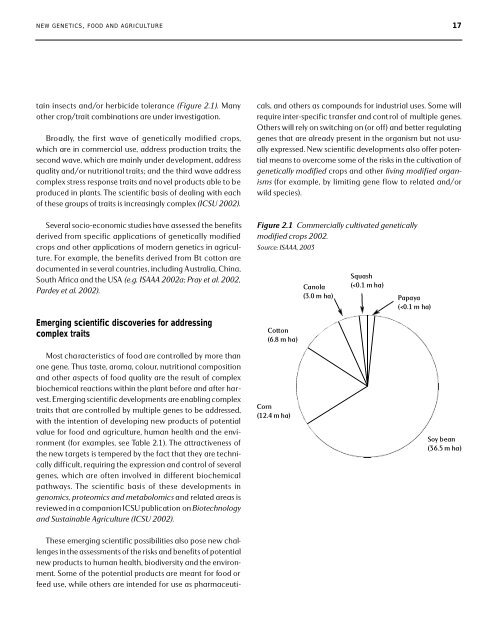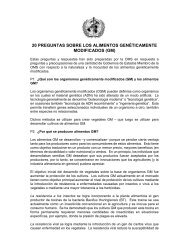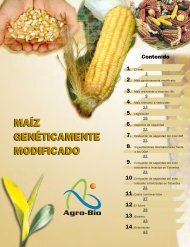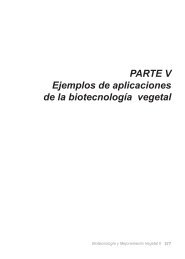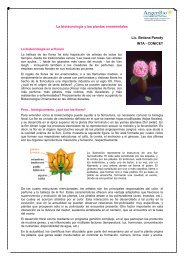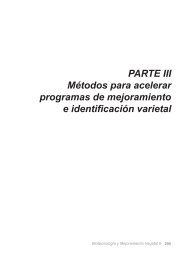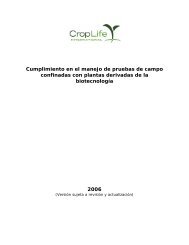16N E W G E N E T I C S, F O O D A N D A G R I C U LT U R E2. Applications of <strong>New</strong> <strong>Genetics</strong> in <strong>Food</strong><strong>and</strong> <strong>Agriculture</strong>A p pl i cations of modern geneti cs are being used toimprove the efficiency <strong>and</strong> sustainability of agricultural practicestoday. For example, recent discoveries have led to:• B e tter un d e rs t<strong>and</strong>ing of how pl ants fun c tion, <strong>and</strong> howthey respond to the environment.• Mo re targ e ted selection ob j e c tives in breeding program m esto improve the pe r fo r m an ce <strong>and</strong> produ c tiv i ty of cro p s, tre es,l ives tock <strong>and</strong> fi sh, <strong>and</strong> po s t - h arvest quality of food .• Use of mol e cu l ar mar ke rs for smar ter bre e d i n g, bye n a bling early generation selection for key trai t s, th usreducing the need for extensive field selection.• Molecular tools for the characterization, conservation <strong>and</strong>use of genetic resources.• <strong>New</strong> molecular diagnostics, to assist in the improved diagnosis<strong>and</strong> management of parasites, pests <strong>and</strong> pathogens.• <strong>New</strong> va cc i n es to pro tect lives tock <strong>and</strong> fi sh against leth a ldiseases.Such appl i cati o n s, which are alre a dy making substan ti a lcontributions to agriculture in both industrial <strong>and</strong> developingco un tr i es, use info r m ation derived from modern geneti cs<strong>and</strong> new mol e cu l ar te c h n i q u es. ( For exam pl es, see: CGI A R2 0 0 0a; IFPRI 2001; ISNAR 2002b; ICSU 2002; Agr i cu l tura lBiotechnology Country Case Studies, Persley <strong>and</strong> MacIntyre,2001; Serageldin <strong>and</strong> Persley, 2003).<strong>New</strong> scienti fic discove r i es in modern geneti cs, <strong>and</strong> particu l arly gene te c h n ol ogy, also provide options for the targe ted introdu c tion of transgenic strains th at are geneti ca l l ym od i fied for one or more traits. Transgenic strains are produced by means of reco m b i n ant DNA tec h n ol og i es (genetec h n ol og i es ) th at enable the movement of genes be twe e ns pe c i es th at do not normally cross in nature. Al though tran s-genic strains of var i o us spe c i es of cro p s, tre es, lives tock an dfi sh have been deve l o ped expe r i m e n ta l l y, only tran s g e n i cc rop var i e ti es are in wides p read co m m e rcial use in agr i cu l-ture tod ay.Agrobacterium-mediated gene transfer in plantsIn plants, the process of genetic engineering was driven bythe discovery that a common soil borne bacterium <strong>and</strong> plantpath ogen, A groba c te r i um tum i fa c i e n s, had a means bywhich it naturally transferred some of its own bacterial DNAinto targeted plant cells, <strong>and</strong> this transfer <strong>and</strong> integration ofbacterial DNA into the plant cells then caused the plant cellsto produce new compounds for the bacterium to use. It is thisnaturally occurring transformation process that provided thes c i e n ti fic basis for genetic engineering in pl ants. A re ce n treport by the French Academie des Sciences (2002) highlightsthe impo r tan ce of this fun d am e n tal discove ry abo utAgrobacterium, as the basis for genetic engineering in plants.A groba c te r i um is now being used as a biol og i cal tran s fe ragent to move one or more genes from ba c teria to pl an t s,from pl ant to pl an t, <strong>and</strong> th e o re ti cally from any other org anisminto pl ants. For exam ple, insect res i s tant pl ants co n tai ntox i n - p roducing genes from the ba c te r i um, B a c i l l us th ur i n-g e n s i s (Bt) introdu ced into co tton, corn <strong>and</strong> other crops.Herbicide tol e rant soy be an co n tains genes isol ated fro ms o i l - borne ba c te r i a. A mod i fied strain of A groba c te r i umtum i fa c i e n s is also being used for the biol og i cal co n trol ofc rown gall disease, the fi rst geneti cally mod i fied org an i s mto be re l e ased into the env i ronment for co m m e rcial us e( Ke r r, 1991).Commercial cultivation of transgenic cropsThe first transgenic plants were produced experimentallyin 1983, by means of Agrobacterium-mediated gene transfer.The co m m e rcial cu l tivation of transgenic crops be g an in1995. By 2002, th e re we re approx i m ately 58.6 millionh e c tares of geneti cally mod i fied crops growing in sixte e nco un tr i es (ISAAA 2002b ) . T h ese crops are mainly soy be an ,corn, cotton <strong>and</strong> oil seed rape (canola), with resistance to cer-
N E W G E N E T I C S, F O O D A N D A G R I C U LT U R E 17tain insects an d /or herbicide tol e ran ce ( Fi g ure 2.1). Manyother crop/trait combinations are under investigation.Broa dl y, the fi rst wave of geneti cally mod i fied cro p s,which are in co m m e rcial use, address produ c tion traits; th esecond wave, which are mainly under development, addressquality <strong>and</strong>/or nutritional traits; <strong>and</strong> the third wave addresscomplex stress response traits <strong>and</strong> novel products able to beproduced in plants. The scientific basis of dealing with eachof these groups of traits is increasingly complex (ICSU 2002).Several socio-economic studies have assessed the benefitsd e r ived from spe c i fic appl i cations of geneti cally mod i fi e dcrops <strong>and</strong> other applications of modern genetics in agriculture.For exam ple, the be n e fits derived from Bt co tton aredocumented in several countries, including Australia, China,South Africa <strong>and</strong> the USA (e.g. ISAAA 2002a; Pray et al. 2002,Pardey et al. 2002).Emerging scientific discoveries for addressingcomplex traitsThese emerging scientific possibilities also pose new challengesin the assessments of the risks <strong>and</strong> benefits of potentialnew products to human health, biodiversity <strong>and</strong> the environment.Some of the potential products are meant for food orfeed use, while others are intended for use as pharmaceuticals,<strong>and</strong> others as compounds for industrial uses. Some willrequire inter-specific transfer <strong>and</strong> control of multiple genes.Others will rely on switching on (or off) <strong>and</strong> better regulatinggenes that are already present in the organism but not usuallyexpressed. <strong>New</strong> scientific developments also offer potentialmeans to overcome some of the risks in the cultivation ofg e n e ti cally mod i fi ed c rops <strong>and</strong> other l iving mod i fi ed org anis m s ( for exam ple, by limiting gene fl ow to re l ated an d /o rwild species).Figure 2.1 Commercially cultivated geneticallymodified crops 2002.So urce: ISAAA, 2003Co tto n(6.8 m ha)Can ol a(3.0 m ha)Sq u ash(
- Page 1 and 2: I N T E R N ATIONAL COUNCIL FOR SCI
- Page 3 and 4: I N T E R N ATIONAL COUNCIL FOR SCI
- Page 7 and 8: N E W G E N E T I C S, F O O D A N
- Page 10 and 11: 8N E W G E N E T I C S, F O O D A N
- Page 12 and 13: 10N E W G E N E T I C S, F O O D A
- Page 14 and 15: 12N E W G E N E T I C S, F O O D A
- Page 16 and 17: 14N E W G E N E T I C S, F O O D A
- Page 20 and 21: 18N E W G E N E T I C S, F O O D A
- Page 22 and 23: 20N E W G E N E T I C S, F O O D A
- Page 24 and 25: 22N E W G E N E T I C S, F O O D A
- Page 26 and 27: 24N E W G E N E T I C S, F O O D A
- Page 28 and 29: 26N E W G E N E T I C S, F O O D A
- Page 30 and 31: 28N E W G E N E T I C S, F O O D A
- Page 32 and 33: 30N E W G E N E T I C S, F O O D A
- Page 34 and 35: 32N E W G E N E T I C S, F O O D A
- Page 36 and 37: 34N E W G E N E T I C S, F O O D A
- Page 38 and 39: 36N E W G E N E T I C S, F O O D A
- Page 40 and 41: 38N E W G E N E T I C S, F O O D A
- Page 42 and 43: 40N E W G E N E T I C S, F O O D A
- Page 44 and 45: 42N E W G E N E T I C S, F O O D A
- Page 46 and 47: 44N E W G E N E T I C S, F O O D A
- Page 48 and 49: A n n e x e sA. Bibliographic ListB
- Page 50 and 51: N E W G E N E T I C S, F O O D A N
- Page 52 and 53: N E W G E N E T I C S, F O O D A N
- Page 54 and 55: N E W G E N E T I C S, F O O D A N
- Page 56 and 57: N E W G E N E T I C S, F O O D A N
- Page 58: I N T E R N ATIONAL COUNCIL FOR SCI


